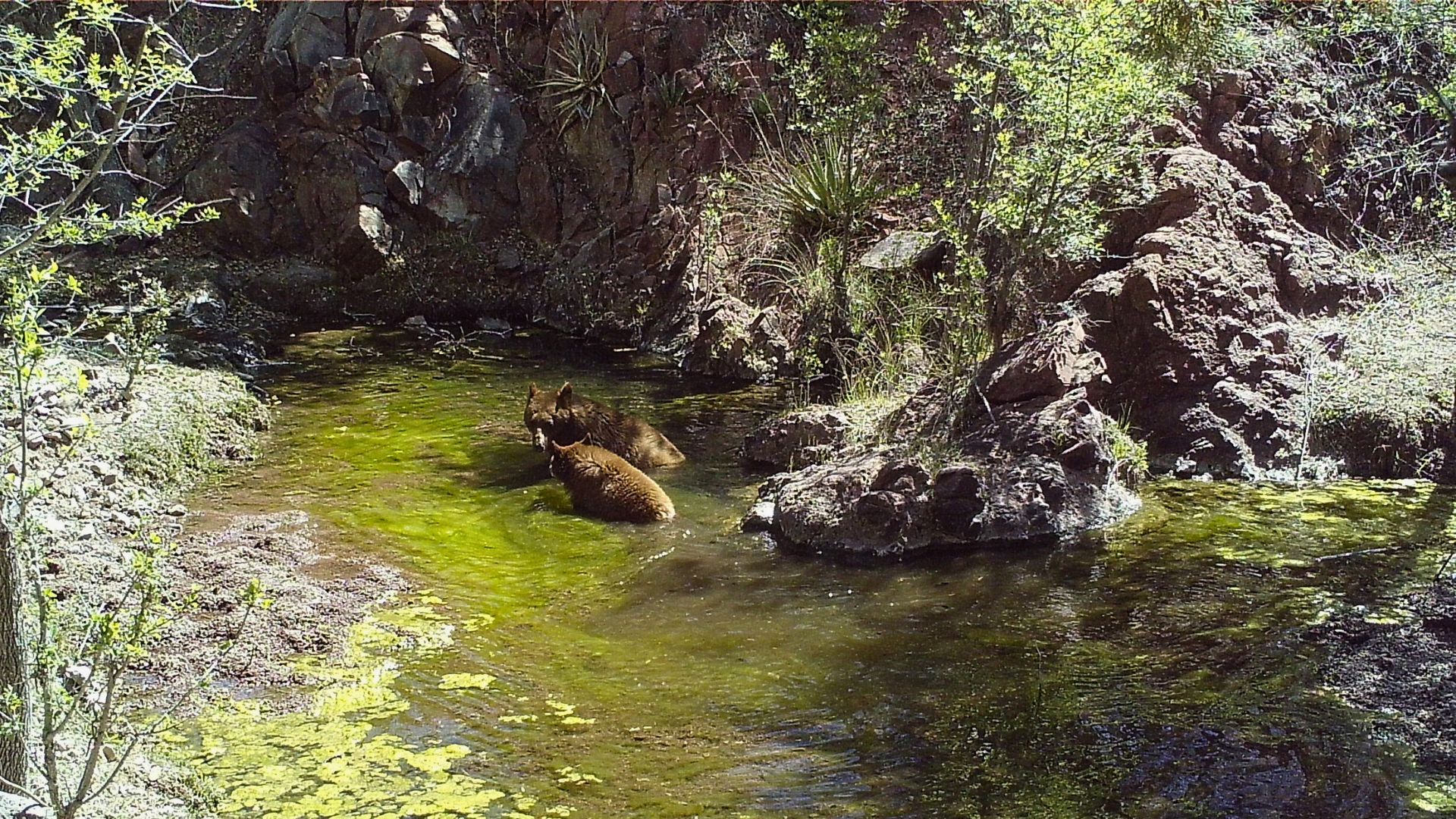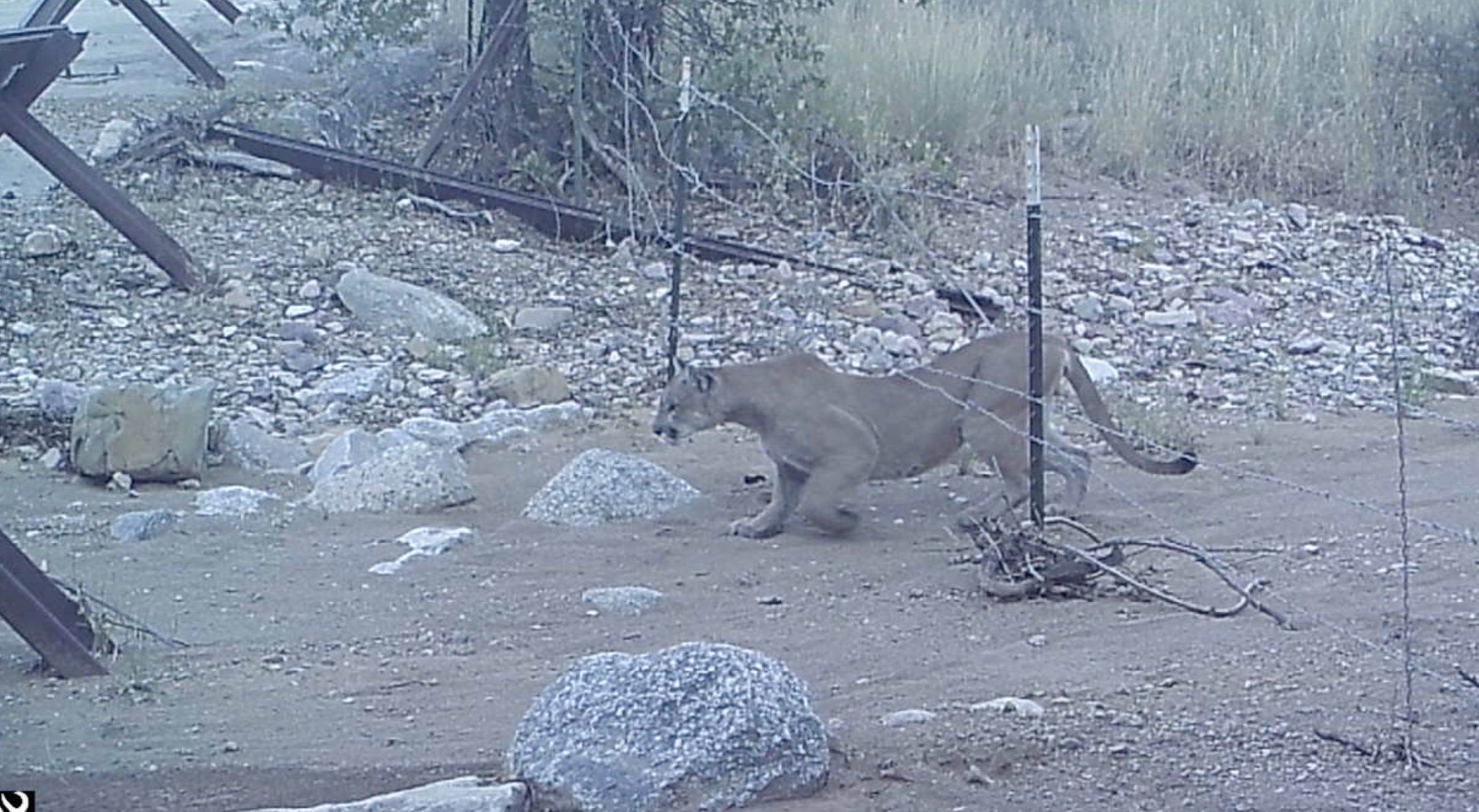Will Border Wall Construction Deplete Desert Springs?
Volunteers are monitoring natural springs in an Arizona wilderness to understand what the construction of a border wall will cost wildlife.

Illustration by Julia Kuo
Esta historia está disponible en español. This story is available in Spanish.
When Chris Schnaufer goes hiking in southern Arizona’s picturesque San Rafael Valley, he keeps an eye out for one particular thing: spots where underground water has broken through the surface and formed a natural spring. The wilderness of rolling grasslands and towering cottonwoods is home to abundant wildlife that depends on the many local springs for survival. But they may be at risk.
The Trump administration is erecting a 27-mile section of border wall that will cut across the valley’s wide-open shortgrass prairie. In the process, construction workers will draw copious amounts of groundwater to fashion cement footers for 30-foot-high steel bollards. This worries conservationists, who say wall construction could deplete springs that sustain animals in one of the last open wildlife corridors between Arizona and Mexico.
“If you’re pulling water out of the bottom of this water table, it’s going to sink and you’re not going to see the springs anymore,” Schnaufer says. “Then much of the life that depends on the surface water is going to have trouble.”
The retired software developer is one of dozens of “Spring Seeker” volunteers with the Tucson conservation nonprofit Sky Island Alliance, which began monitoring springs near the border before construction began in mid-September. The goal is to compare the flow of springs within about three miles of the wall before and after construction to understand any changes the process may cause, says Dr. Sarah Truebe, the nonprofit’s habitat conservation manager.
“Springs are some of our only water sources in this whole region,” she says. “We live in the desert and we really need these water sources for wildlife to survive.”

Reduced access to water is just one threat conservationists say the wall poses to wildlife. Current border structures include cattle fencing and low vehicle barriers crafted with old railroad rails, which have long allowed wildlife to pass through. But according to a July report by the Center for Biological Diversity, the new wall will restrict the movement of black bears, mountain lions, mule deer, and other animals through the region, which is crucial for the genetic health of those species. Additionally, the wall could cut Arizona’s endangered jaguar populations off from their breeding grounds in Mexico.
To build the barrier as quickly as possible, Homeland Security Secretary Kristi Noem has waived dozens of federal laws and regulations that call for environmental and cultural review. Over the years, Congress has approved several laws that grant the Department of Homeland Security power to sidestep statutes including the National Environmental Policy Act, the Endangered Species Act, and the Clean Water Act.
The waivers are being legally challenged by the Center for Biological Diversity and the advocacy group Conservation CATalyst. Their July lawsuit was held up in U.S. District Court in Tucson due to the federal shutdown until a federal judge ruled that it could proceed on November 5. In the meantime, construction of the wall continued.
The Arizona construction project is one of several being fast-tracked along stretches of the border that include protected state and federal land. In Texas, for example, a wall will be built on 13 tracts in the Lower Rio Grande Valley National Wildlife Refuge that provides habitat for the endangered ocelot and a multitude of birds.
In the San Rafael Valley, the wall will slice through an area with a rich diversity of mammals, reptiles, insects, birds, and plants. The expansive landscape spreads between soaring mountain ranges—known as Madrean Sky Islands—that transition from desert lowlands to pine and oak-studded peaks on both sides of the border. Truebe estimates that up to 4,000 springs may be scattered across Arizona’s portion of the Sky Islands region.

The push for wall construction to close gaps and deter unlawful migration along the 1,954-mile international boundary comes at a time when overall border crossings continue to plummet under President Trump’s policies and Mexico’s efforts to halt northbound border crossings.
In August of this year, Customs and Border Protection (CBP) reported 1,068 migrant encounters in the entire 262-mile Tucson sector of Arizona’s border, which includes the San Rafael Valley. That’s a 91% decrease from August 2024.
It’s not clear from the available data how many people might be crossing the border in the San Rafael Valley, specifically, as CBP only releases total-sector statistics. But the Sky Island Alliance, whose network of cameras monitors animal movements along border infrastructure, captured a monthly average of just five people—and 180 white-tailed deer—in the valley over the last five years, says Eamon Harrity, the group’s wildlife program manager. (It’s not possible to tell whether people captured on camera are migrants, hikers, or others.)
The San Rafael Valley “has almost no people crossing, so the wall is going to be built at $300 million to stop a handful of people right now,” he said in a virtual talk on August 28, alluding to a contract that the federal government awarded to the North Dakota company Fisher Sand & Gravel for the project. A spokesperson for CBP declined to comment on the project because of the ongoing lawsuit.

Last year, Sky Island Alliance and the Wildlands Network in Salt Lake City, Utah, published a border wildlife study in the journal Frontiers in Ecology and Evolution that found that animals including black bears, deer, and wild turkeys were unable to get through infrequent, small openings built into existing steel border wall sections in the region. “The impact will be severe,” Harrity says of the new wall.
Conservation groups are pushing for the integration of more frequent and larger wall openings for animals if legal challenges fail to stop border construction. Meanwhile, Sarah Truebe and volunteers like Chris Schnaufer will keep searching for new and previously documented springs, and recording spring flows as well as the presence of fish, insects, birds, and vegetation with a smartphone app.
Their spring data will be shared with pertinent state and federal agencies that might help mitigate any impact from the wall, Truebe says. The alliance, whose work on springs includes restoration, will also continue to share its data with the Springs Stewardship Institute in Flagstaff, Arizona.
“Springs are not just hydrologic commodities, but they’re ecosystems with deep biological and cultural connections to the landscape,” says Dr. Larry Stevens, the institute’s director.
In the arid state of Arizona, the springs scattered across the Sky Islands region play “a big ecological role in the landscape,” he says. “Birds will fly five miles to get to a spring each day for water.”
Editor’s Note: This story was updated on November 8, 2025, to reflect the status of an ongoing lawsuit.
Lourdes Medrano is a journalist whose work focuses on the US-Mexico borderlands.